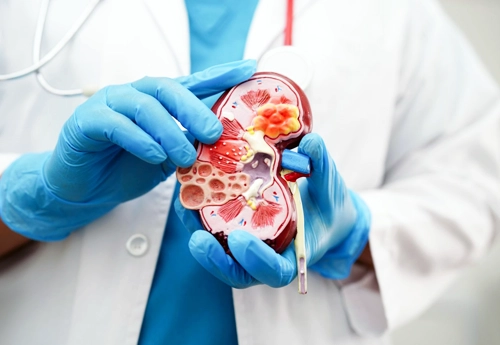He is a urologist who prioritizes patient satisfaction and stands out with his reliable approach and successful treatments.
Minimally Invasive Kidney Stone Surgery
What is a Kidney Stone?
A kidney stone is a hard mass formed by the crystallization and accumulation of certain minerals and salts that are dissolved in the urine. These stones can develop inside the kidneys or anywhere along the urinary tract. The most common types are calcium oxalate stones; however, stones containing uric acid, cystine, or struvite can also occur.

Kidney stones usually begin at a microscopic level and gradually grow to sizes that can cause clinical symptoms. The size, shape, and location of the stone are important factors that affect the severity of the symptoms experienced by the patient.
What Causes Kidney Stones?
One of the most important causes of kidney stone formation is inadequate fluid intake; when not enough water is consumed, urine volume decreases and becomes more concentrated. This leads to a higher accumulation of dissolved minerals and waste products in the urine, allowing minerals to easily crystallize and combine, creating a foundation for stone formation. Additionally, dietary habits significantly affect the risk of kidney stones.
Especially, excessive consumption of salty foods high in sodium increases calcium excretion in the urine, which triggers stone formation. Moreover, when foods rich in oxalate (such as spinach, chocolate, and tea) are consumed in large amounts, the likelihood of oxalate combining with calcium to form crystals in the kidneys rises.
High-protein diets can also increase uric acid levels, which particularly raises the risk of uric acid stone formation. The combination of these factors facilitates the development of kidney stones, making balanced fluid intake and healthy eating habits essential to prevent stone formation.
Symptoms of Kidney Stones
The most characteristic symptom in individuals with kidney stones is severe flank pain (renal colic). The pain usually starts suddenly and radiates from the lower back to the groin area. As the stone moves, the pain may come and go in waves. Other symptoms may include nausea, vomiting, blood in the urine (hematuria),frequent urination, burning sensation during urination, and fever. If the stone blocks the urinary tract, urine flow may stop, which can lead to kidney damage.
- Severe flank pain (usually felt in the lower back, side, or groin)
- Blood in the urine (hematuria) or pink/red discoloration
- Frequent urination or burning sensation when urinating
- Nausea and vomiting
- Difficulty urinating or feeling of interrupted urine flow
- Fever and chills (when infection develops)
- Sudden, cramp-like pains
- Changes in urine odor or cloudiness
- Discomfort or pressure in the lower abdomen
- Weakness and general malaise
How is Kidney Stone Treatment Performed?
Kidney stone treatment varies depending on the size and location of the stone. Small stones are usually managed with increased water intake and painkillers. Larger or problematic stones may require shock wave lithotripsy (ESWL),endoscopic methods, or minimally invasive kidney stone surgery (percutaneous nephrolithotomy). After treatment, patients are advised on dietary and lifestyle modifications to prevent stone recurrence.
Minimally Invasive Kidney Stone Surgery in Turkey
Minimally invasive kidney stone surgery is a general term for surgical techniques that aim to remove or break kidney stones using endoscopic methods without making large incisions on the skin. These surgeries are performed through natural urinary passages or small skin incisions using a camera and special surgical instruments. Compared to open surgery, it causes less tissue trauma, resulting in a more comfortable postoperative recovery and a lower complication rate for the patient.
When is Minimally Invasive Kidney Stone Surgery Preferred?
Minimally invasive surgical methods are generally preferred for kidney stones larger than 2 cm or when medical treatments or extracorporeal shock wave lithotripsy (ESWL) fail to dissolve the stones. Surgery is also considered when the stone blocks urine flow, causes infection, or results in severe pain. Stones located deep within the kidney or stuck in the ureter may also require minimally invasive surgery. This approach is particularly effective in cases of recurrent stones and anatomical abnormalities.
Methods of Minimally Invasive Kidney Stone Surgery
1. Ureteroscopy (URS)
In ureteroscopy, the ureteroscope is inserted through the urethra and advanced into the ureter. The stone is visualized with a camera and fragmented with a laser before being removed. This method is usually suitable for stones in the ureter and is performed under general anesthesia.
2. Percutaneous Nephrolithotomy (PNL)
In percutaneous nephrolithotomy, a small incision is made in the back to access the kidney directly. Stones are broken up and removed using an endoscope. This method is preferred for large and complex stones. A nephrostomy tube is placed after the surgery for drainage.
3. Flexible Ureteroscopy (Retrograde Intrarenal Surgery - RIRS)
A thin, flexible ureteroscope is used to reach stones inside the kidney through natural urinary pathways. Stones are broken down with a laser and removed in small fragments. This high-tech method is generally preferred for stones smaller than 2 cm.
Preparation Process Before Minimally Invasive Kidney Stone Surgery
Before minimally invasive kidney stone surgery, detailed imaging (CT scan, ultrasound) is performed to determine the location and size of the stone. Blood tests, urine culture, and anesthesia evaluation are also conducted. If there is a risk of infection, antibiotic treatment may be planned. Medications such as aspirin and blood thinners should be stopped before the surgery. Additionally, the patient is informed about the procedure, and consent is obtained.
Advantages of Minimally Invasive Surgery Compared to Open Surgery
The main advantage of minimally invasive surgical techniques is that they are less invasive. Unlike open surgery, large skin incisions are not needed. This results in less blood loss, a lower risk of infection, less pain, and a faster recovery process. Hospital stay is shorter, and the return to daily life is quicker. It also has aesthetic benefits, leaving almost no visible scars.
Costs of Minimally Invasive Kidney Stone Surgery
The cost of minimally invasive kidney stone surgery varies depending on many factors. These include the technology used, the location of the hospital, the experience of the surgeon performing the operation, the size and position of the stone, and the duration of the surgery.
Duration of Minimally Invasive Kidney Stone Surgery and Hospital Stay
The duration of minimally invasive kidney stone surgery varies depending on the chosen method and the complexity of the stone but generally ranges from 30 minutes to 2 hours. Patients undergoing URS or RIRS are usually discharged the same day or the next day, while after PNL, a hospital stay of 2-3 days may be required. If a drainage tube is placed, this period may be extended.
Recovery Process After Minimally Invasive Kidney Stone Surgery
The recovery process after minimally invasive kidney stone surgery is generally comfortable. Patients can usually return to their daily activities within a few days. Blood may be seen in the urine for a while, which is normal. Pain is typically mild and can be controlled with analgesics. If a ureteral stent is placed, it is usually removed within 1-2 weeks. Complete recovery may take several weeks.
Precautions After Minimally Invasive Kidney Stone Surgery
- Drink plenty of water to increase urine flow and help pass stone fragments
- Take painkillers and medications regularly as prescribed by your doctor
- Immediately consult a healthcare facility if you experience abnormal symptoms such as bleeding in the urine or severe pain
- Avoid heavy exercise and lifting heavy objects during the first few days after surgery
- Follow hygiene rules carefully to reduce the risk of infection
- Watch for signs of infection such as burning during urination, urgency, or fever
- Do not miss routine check-ups and attend all follow-up appointments given by your doctor
- Pay attention to your diet and avoid excessively salty or protein-rich foods that may trigger stone formation
- Inform your doctor if you notice significant darkening of urine color or a foul odor
- Rest adequately after surgery and avoid overexertion
Possible Risks of Minimally Invasive Kidney Stone Surgery
Like all surgical procedures, minimally invasive kidney stone surgery carries some risks. These include infection, bleeding, narrowing of the urinary tract, urine leakage, or damage to surrounding organs. In experienced hands, these risks are quite low. Complaints related to stents (such as frequent urination or burning) are common but temporary.
Can Kidney Stones Recurrence After Surgery?
While surgery removes the existing stone, it does not completely prevent new stones from forming. Kidney stone patients should be metabolically evaluated and provided with dietary and lifestyle recommendations. Regular follow-up, urine tests, and imaging can detect recurrence early. Medical prevention methods may also be applied for high-risk patients.
How to Prevent Kidney Stone Formation?
Drinking at least 2.5 to 3 liters of water daily significantly reduces the risk of kidney stones. Excessive consumption of salt, oxalate-rich foods (such as spinach, chocolate, and tea),red meat, and refined sugar should be avoided. Calcium supplements should not be taken without consulting a physician. In some patients, citrate supplements may be recommended to help balance urine pH. Protecting against urinary tract infections is also important.
Sexual Activity After Minimally Invasive Kidney Stone Surgery
Returning to sexual activity after minimally invasive kidney stone surgery is usually possible within a short time. However, sexual intercourse is not recommended during the first few days due to sensitivity in the urinary tract and discomfort from stents. The timing for resuming sexual activity depends on the type of surgery, the patient’s overall condition, and the healing process. Sexual activity can be safely resumed with the doctor’s approval.
About MeOp. Dr. Emrah Topbaş
Urology Specialist Surgeon Dr. Emrah Topbaş is specialized in prostate, andrology, and pelvic floor treatments. He provides modern diagnostic and treatment services in Ankara.
Read MoreHospitalsContracted Hospitals
At his clinic in Ankara, which has agreements with the Social Security Institution (SGK) and many private health insurance companies, he provides comprehensive healthcare services for the diagnosis and treatment of urological diseases.
Read MoreIn the PressVisual and Written Media
He closely follows current developments in the field of urology and frequently appears in the media, contributing to interviews and informative content aimed at raising public awareness.
Read More



